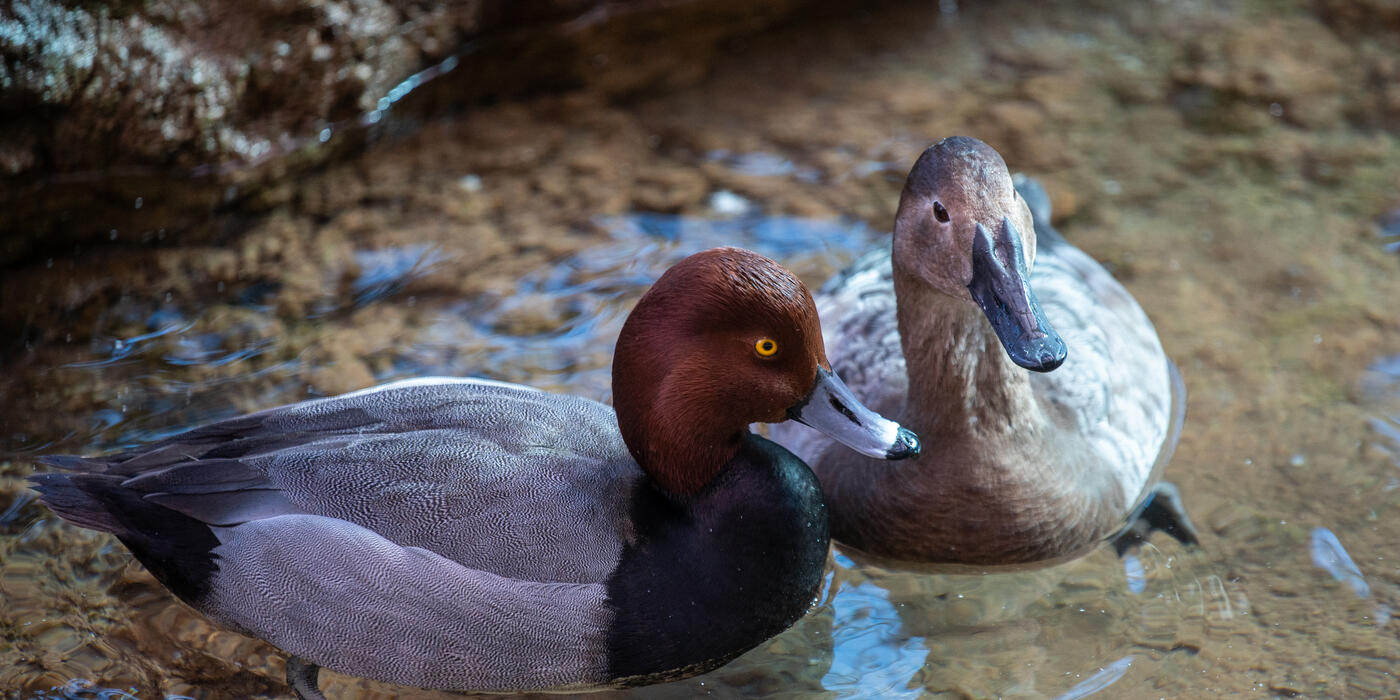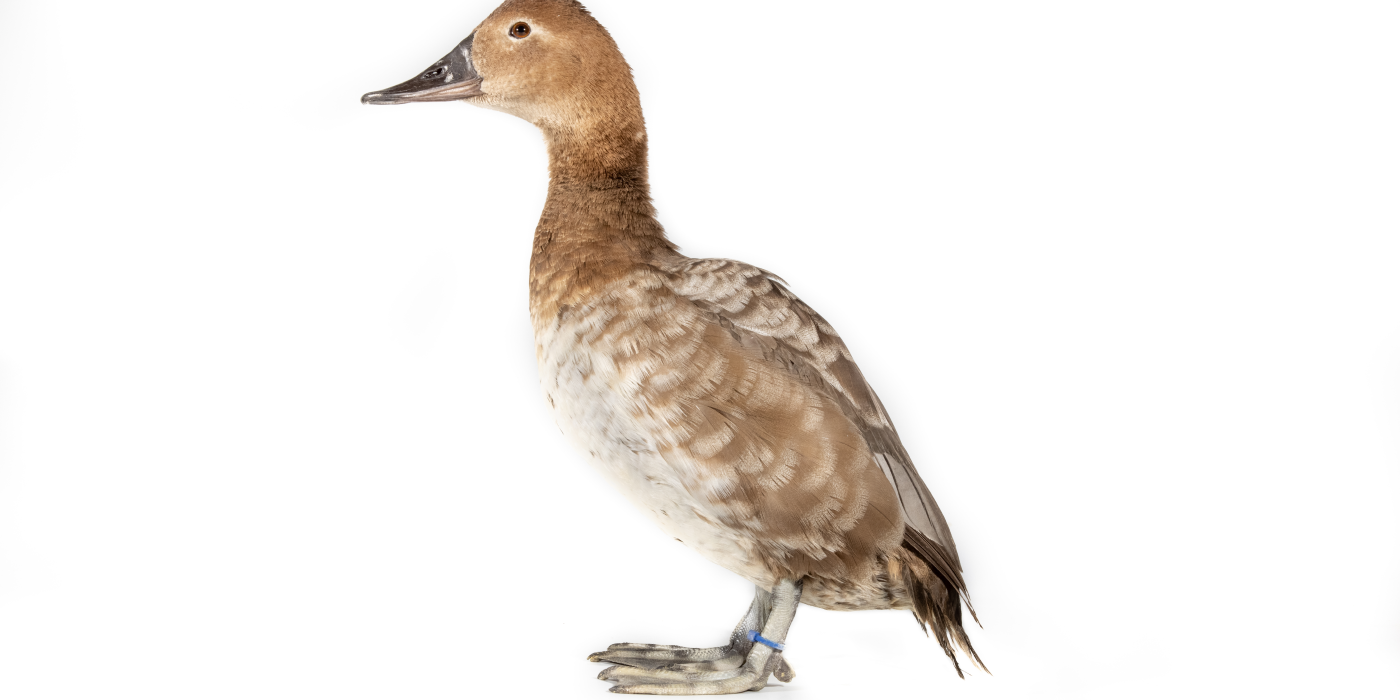Physical Description
Like other birds, these large diving ducks exhibit seasonal and sexual dimorphism, meaning their feather color changes based on the season. Male canvasbacks have white bodies, black chests and tails, and a chestnut head during the breeding season. For the rest of the year, the males’ colors are more brown throughout. Females have pale, off-white bodies and gray-brown bodies and tails.
Canvasbacks’ black bills seamlessly line up with their long, narrow and sloping heads.
Size
Canvasbacks are the largest diving duck in North America. They are roughly 20 to 21 inches (50 to 53 centimeters) long and have a 31 to 35 inch (79 to 89 centimeter) wingspan. Both males and females on average weigh between 2.5 and 2.7 pounds (1.13 and 1.22 kilograms), with males being slightly larger.
Native Habitat
During their spring and summer breeding season, canvasbacks are among many species of waterfowl that flock to North America’s flooded northern prairies, sometimes called the Prairie Pothole region. This region is part of the Great Plains and primarily focuses in the Upper Midwestern U.S. Here, these ducks live in temperate grasslands that are seasonally flooded with melted snow and spring rains, forming "potholes" of water that dot the landscape.
These ducks then fly south in the fall. They primarily winter on California or Texas coasts, or in northern to central Mexico. When selecting their wintering grounds, canvasbacks look for large bodies of water that contain large amounts of submerged aquatic vegetation. Historically, canvasbacks would also winter in the Chesapeake Bay. However, the continuing decrease of this favored food source has led to fewer ducks wintering there.
Communication
Canvasbacks are not particularly loud ducks. Males will make a soft cooing vocalization to the females, who will answer with a soft “krrr krrr” sound.
Food/Eating Habits
Primarily diving for their food, canvasbacks mostly eat aquatic plants’ leaves, roots and seeds. Their preferred food is a plant called Valisineria americana, which is more commonly called celery root or wild celery. These diving ducks have also been known to eat mollusks, clams, insects and some small fish.
Social Structure
Canvasbacks are social birds when not breeding. They are often seen gathering in large flocks with other medium-to-large diving ducks like redheads and scaups during the winter.
Courtship and pair formation mostly occurs at stopover points throughout the canvasback’s spring migration. Canvasbacks are seasonally monogamous. After a female chooses her mate, they will stay together until the fall migration.
Reproduction and Development
Canvasback nests are commonly found in marshes. The female canvasback will build the nest by herself with sturdy reeds and grasses. The bulky structure sits above water, on the stems of marsh plants.
Depending on the nesting site’s size and quality, canvasbacks will sometimes lay their eggs in another canvasback’s nest. Redhead ducks are known for laying their eggs in canvasback nests as well. These brood parasites are able to drop their eggs off because canvasbacks do not defend their nest site very well. If this does occur, the nest’s resident canvasback will lay less eggs.
On average, a female canvasback will lay between five to 12 eggs. Ducklings hatch after 23-29 days and are led into the water by the female within hours. Ducklings forage and feed themselves. Females stay with the ducklings for several weeks, but leave them before they fledge, which is around 60 to 70 days old.
Conservation Efforts
In the 19th century, canvasbacks were heavily hunted for food. Hunters believe celery root, the canvasback’s favored food, made these ducks one of the most delicious game birds. Commercial market hunting almost drove canvasbacks to extinction. The Migratory Bird Treaty Act of 1918 was the first step toward saving this bird, as it outlawed market hunting.
Wetland habitat loss is another threat to canvasbacks and other diving ducks. Proceeds from the Duck Stamp, which must be purchased by every duck hunter in the United States, go toward conserving these wetland habitats.
Help this Species
Be a smart consumer, and check the ingredients label. More than 50 percent of packaged foods, as well as many soaps, cosmetics and household products, contain palm oil. Always choose certified palm oil products that support sustainable production and prevent deforestation.
Organize or attend a stream, river, lake or other waterway cleanup in your area to preserve aquatic habitats for local species.
Are you a hunter? You can be an incredible ally for conservation! Check the conservation status of the animals you hunt and use methods that don’t impact other animals.
Avoid single-use plastics, such as plastic bottles, bags and utensils. Choosing reusable options instead can help reduce plastic pollution.
Conservation starts with you! Join a citizen science project where you can help collect valuable data for scientists. Encourage your friends and family to get involved too.
Protect local waterways by using fewer pesticides when caring for your garden or lawn. Using fertilizers sparingly, keeping storm drains free of litter and picking up after your pet can also improve watershed health.
Plant native flowers in your garden to help feed resident and migrating pollinators. You'll make your lawn beautiful and help wildlife at the same time!
Smithsonian's National Zoo and Conservation Biology Institute. (n.d.). Canvasback. Retrieved December 29, 2025, from https://nationalzoo.si.edu/animals/canvasback




